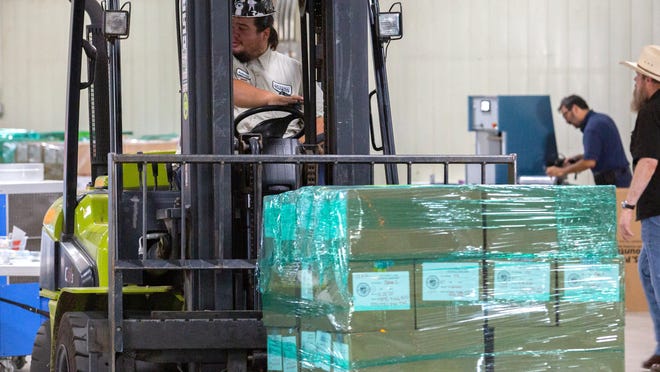- Migrant encounters at the U.S.-Mexico border saw their first-to-month decline since September in January, according to the latest statistics from U.S. Customs and Border Protection.
- The U.S. Border Patrol reported more than 1.6 million encounters with migrants along the U.S.-Mexico border last fiscal year– the highest annual total on record.
- The agency's January numbers, released last week, also revealed a troubling trend: The number of fentanyl seizures climbed by 57%.
AUSTIN, Texas — The number of migrants encountered at the Southwest border decreased by 14% in January from the previous month, signaling the alarming rise in asylum-seekers at the border may be leveling off, according to the latest statistics from U.S. Customs and Border Protection.
More than one-fourth of those encounters were repeat-crossers, pointing to an increase in migrants who were expelled under policies such as the "Remain in Mexico" program or Title 42, which returns migrants to Mexico to prevent the spread of coronavirus, and attempted to get back into the U.S. to seek asylum.
In January, border officials encountered 153,941 migrants at the Southwest border, down from 179,219 in December – the first month-to-month decline since September, according to statistics released Friday. Since the start of this fiscal year on Oct. 1, agents have encountered 672,838 migrants.

Though the January decline wasn't steep, it may signal President Joe Biden's efforts to spread a message to Central American migrants that the U.S.-Mexico border is not open may be getting through, said Tony Payan, director of the Center for the United States and Mexico at Rice University's Baker Institute for Public Policy.
"It's good progress for a single month," Payan said. "The deterrent effect might be finally paying off."
Last year, Biden and congressional lawmakers unveiled a $4 billion relief plan to Central America aimed at tamping down corruption and creating refugee processing centers to discourage migrants from traveling to the U.S.-Mexican border. The proposal, part of the U.S Citizenship Act of 2021, remains in congressional committee. Biden also dispatched emissaries, including Vice President Kamala Harris, to meet with regional leaders.
'HORROR MOVIE' THAT WON'T END:One family’s haunting tale of trauma years after border separation
Chronic poverty and gang violence in Guatemala, Honduras and El Salvador, coupled with two devastating hurricanes in 2020 that left hundreds of thousands displaced, recently led to a record-high number of asylum-seekers at the U.S.-Mexico border.
The dramatic rise in migrants at the border began in March, when agents encountered 173,277 and continued throughout the fiscal year, according to CBP numbers.

Last fiscal year, U.S. Border Patrol reported more than 1.6 million encounters with migrants along the U.S.-Mexico border – the highest annual total on record.
The first three months of fiscal year 2022 began anew with higher-than-average numbers – averaging nearly 173,000 encounters per month.
Biden may have contributed to the rush of migrants at the border by so quickly reversing many of former President Donald Trump's border policies and sending the wrong message to asylum-seekers, Payan said.
January's decline was the first sign of a potential slowing of that rush, he said.
"[The Biden administration] might just have climbed out of that hole and sent the message: It's still difficult to get into the United States," Payan said.
HEADLESS ROBOT DOGS MAY SOMEDAY PATROL U.S.-MEXICO BORDER:What we know about these machines
The agency's January numbers also revealed a troubling trend: While overall the number of narcotic seizures dipped, the number of fentanyl seizures climbed by 57%. The Centers for Disease Control and Prevention are reporting a steep rise in fentanyl-related overdoses across the U.S.
Nationwide, cocaine, methamphetamine and heroin seizures dropped in January, but fentanyl seizures jumped from 26 in December to 65 in January, according to the statistics.
January's drop in migrant encounters at the border stemmed in large part from a steady decline in the number of Central American asylum-seekers, said Adam Isacson, a border security analyst at the Washington Office on Latin America, a research and advocacy group.

The number of migrants from Honduras, Guatemala and El Salvador decreased from a high of more than 94,000 in July to around 31,000 in January, according to the statistics. Meanwhile, the number of Mexican asylum-seekers at the U.S. border has been on the rise, from around 40,000 a month a year ago to nearly 60,000 in January.
"There seems to be a steady decline from that summer peak, really led by less Central Americans," Isacson said of overall migrant-encounter numbers.
'REMAIN IN MEXICO':Supreme Court to revisit Biden administration effort to shut down 'Remain in Mexico' policy
Increased enforcement of Mexico's southern border by Mexican agents likely accounts for some of the drop off in Central American migrant numbers, Payan said. But clashes with drug cartels in the Mexican state of Michoacán – and president Andrés Manuel López Obrador's inability to effectively confront organized crime – are also pushing hordes of Mexicans to the U.S. border to seek asylum, he said.
The growing number of Mexican migrants at the border presents a thornier issue for Biden, since it's not something Mexican immigration agents can help control, Payan said.
"It's one thing to stop non-Mexican migrants from traveling across the southern border, but it's a very different thing when it’s a Mexican citizen," he said. "You can't stop them from going through the country."
Follow Jervis on Twitter: @MrRJervis.
Source link






